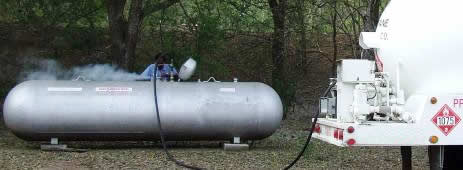
- Frequently Asked Questions - Home
- First Time Propane User
- Propane Tank Color
- Leak Test
- Abnormal Usage and Leaks
- Gallons Lost in LP Gas Leaks
- Checking For Gas Leaks
- Propane Do It Yourself
- Propane Tank Leak
- Exploding Propane Tanks
- Propane Cylinder Explosions
- Valve Open - No Propane
- Propane Tank Disposal
- Propane Regulator Freezing
- Propane BTU Content
- Propane Emergencies
Propane Gas Deliveries

Propane delivery seems simple but propane customers sometimes have questions surrounding the delivery process. These questions are asked routinely of propane dealers and have common explanations involving laws, LP Gas requirements and physics.
How (or Why) did my tank percentage fall so quickly?
This question is often asked during the period immediately following the delivery, or sometimes several days later. Whether the propane tank is being filled partially or completely, the bleeder valve is always used during the delivery process. It is common for the delivery driver to write the ending percentage on the fuel ticket after the delivery which is often 80%, if the tank has been filled. Even if the face gauge reads 75% following delivery, the tank is at 80% because the bleeder valve indicates the actual propane liquid level (above 80%) in the tank, not the face (dial) gauge. See Float Gauge and Fixed Liquid Level Gauge for detailed information about these two propane gauges.
Another instance that may seem confusing to propane consumers involves tank volume following a propane delivery in the afternoon, which is commonly the hotter part of the day. When propane deliveries are made during the hotter parts of the day, the gas has already expanded before it is delivered into the tank and the gauge may read 80% following a fill. Inspecting the tank gauge the following morning may show a significant percentage drop (up to 5%) even if no gas has been used! This does not necessarily indicate a leak. More likely than not, the volume of liquid propane in the tank has contracted in the cooler overnight hours. Also see Propane Tank Color for more information about the effects of heat on liquid propane volume and Propane Volume Correction for an explanation about hot and cold weather delivery issues.
Why are two hoses used during propane delivery?
This is a very common propane delivery question in warmer climates. The additional hose is a vapor return hose and will be used on days when the temperature is rising quickly or is expected to be quite high. The vapor return hose is used to relieve the excess pressure from the tank being delivered into. Remember that as the volume in the tank increases, the pressure is also rising. As a precaution, the vapor return hose is connected to prevent an over-pressure condition which could result in the release of propane through the Safety Relief Valve. A common misperception is that the second hose is being used counteractively to the fill hose. The vapor return hose does not recover liquid propane from your tank during the filling process. It only recovers excess pressure. See Vapor Return Valve for details about this propane delivery process and Propane Liquid and Vapor for information about propane in its two states.
Why is propane spewing out of my tank during delivery?
During propane delivery, the fixed liquid level gauge, also called a bleeder valve is opened as required by law. The driver is not inadvertently letting gas out of the tank. This valve accurately indicates the liquid level in the propane tank and lets the delivery driver know when to stop the filling process. The picture at the top of this page shows the bleeder valve actively being used during a delivery of propane. See Fixed Liquid Level Gauge for a better understanding of its use during the propane delivery process.